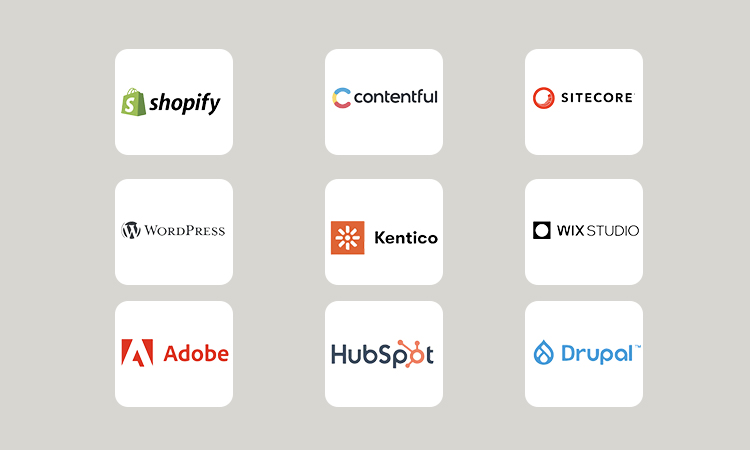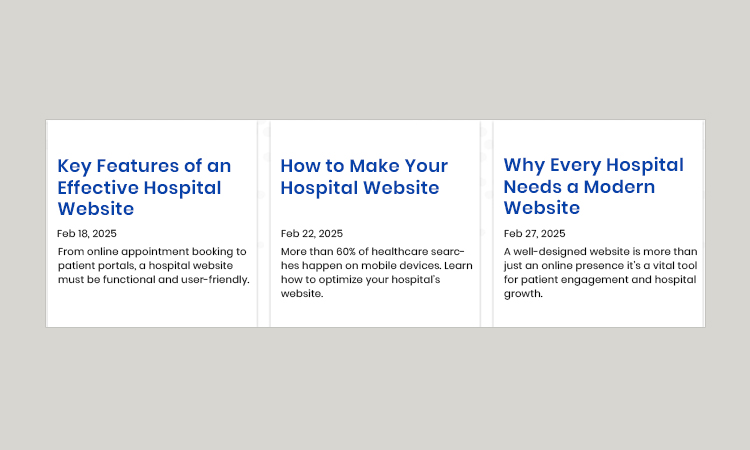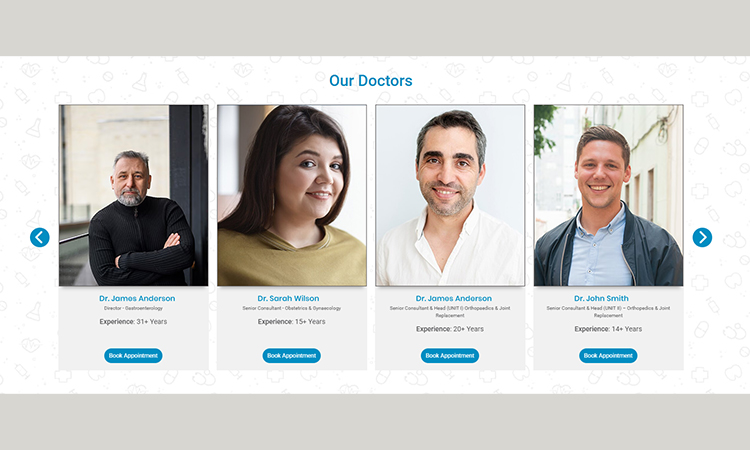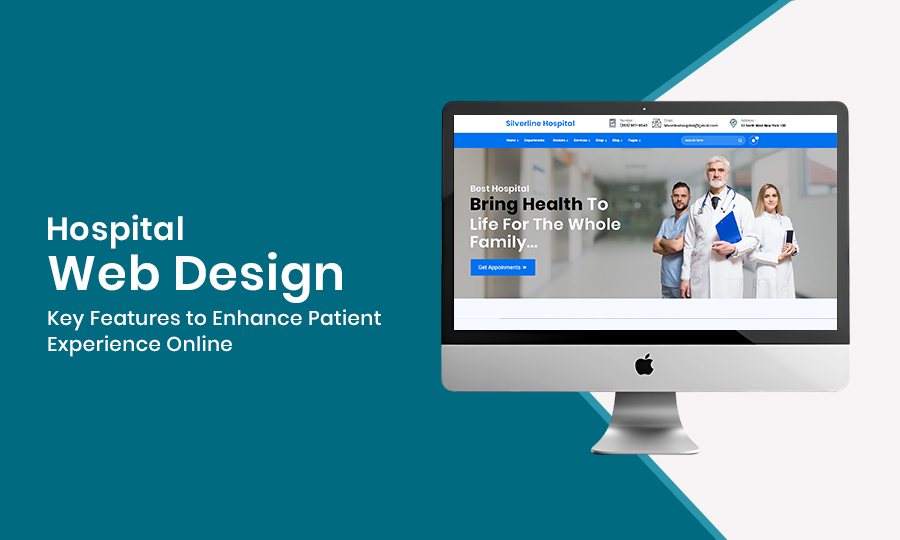Web design for hospitals forms the backbone of today’s healthcare industry. However, keep in mind that no two healthcare organizations are the same. For example, the clinic of a cardiologist will be filled with posters of the heart or brochures on maintaining heart health. Similarly, an urgent care clinic might have posters on emergency resuscitation services. Medical practices are created keeping in mind industry trends or the needs of the patient community.
Just like how clinics define the physical appearance of healthcare professionals, web design for hospitals defines their digital presence. Similar to your clinic, you also need to think carefully about your healthcare website to make it the most credible source of information for your patients.
However, designing a medical website is easier said than done. Today’s tech-savvy patients have high expectations from healthcare providers. Without prior experience or knowledge, you may be lost in a sea of designs, formats, and regulatory complications!
This article is an excellent starting point for building an online presence and refining your medical website design skills. With our curated tips and strategies, you will soon foster positive patient relationships and build a strong brand image for your healthcare organization.
What is Hospital Web Design?
Hospital web design encompasses the processes used to create a website for medical professionals and practices. In today’s digital landscape, web design for hospitals is more than just a collection of attractive pages. They are like the front desks of hospitals, clinics, and doctors. Site visitors want a secure and smooth online experience, similar to how they would want their favorite beauty or shopping web design to be.
A solid website design can be a resource for promoting your brand and encouraging your patients to make essential healthcare decisions. The best healthcare website designs will help new patients learn about your service and also provide them with updates on current medical research.
Why is a Medical Website Important for Hospitals?
A good healthcare web design is like making a map. Its purpose is to help potential patients understand the complexities of medical information. Here are a few more specific reasons why hospitals need to make a proper website for their practice.
1. Online Patient Engagement
Imagine your healthcare website design to be an unending conversation between you and your patients. Features like patient portals and an online appointment booking system will not only provide important healthcare information but also keep them engaged and empower them to manage their health conveniently.
A healthcare website design that is patient-focused is like a remote control for prospective patients. It enables them to stay in touch with doctors from the comfort of their homes.
2. Trustworthiness
Trust is crucial for the medical web design and healthcare industry. When potential patients see your website, they want to feel confident and safe in their decision to choose your hospital.
A premium healthcare website design that is filled with positive patient testimonials and comprehensive service details is sure to instill trust in your patients. It also makes people feel that they are talking to a capable healthcare provider. This will make them reach out to you in the next part of their medical journey.
3. Patient Access
A good medical website is also capable of removing any barriers for patients for whom healthcare is beyond their reach. For example, a good healthcare website design can be a lifesaver for patients who are specially-abled or are living in rural regions.
Web Design for Hospitals: 11 Key Features to Enhance Online Patient Experience
The following guidelines will cover the most essential steps of web design for hospitals. As you read keep in mind your medical specialty and the needs of your target audience. While these practices can be implemented in any healthcare organization, you need to align them to the specific audience you are catering to.
1. Select the Correct CMS

A content management system (CMS) is a tool to start a website, include webpages, begin a blog, and link your site to your social media account. It forms the backbone of your medical website design, which is why you should select it carefully.
For example, you can work with a popular CMS tool like Squarespace or WordPress. After opening a website on these platforms, you might want to include a private patient portal where people can talk directly to healthcare providers and request their medical records.
While WordPress can help you create such a resource, you might need more plugins and extensions to make it specific to your practice. For this reason, a good idea would be to work with professional healthcare website design company that specializes in web design for hospitals.
2. Ensure Mobile Friendliness
Recent research suggests that almost 90% of people rely on a smartphone to go online. Such numbers mean that healthcare professionals cannot overlook prospective patients who will visit their website using their phones.
A mobile-friendly web design for hospitals will not only improve patient experience but also increase their visibility in Google search engines. This is because interactive and readable webpages that easily load on a smartphone screen are more likely to come up in the search results of site visitors.
Here are the steps to make a mobile-friendly healthcare website:
- Homepage Optimization: Include a long-scrolling homepage with short bursts of medical information. This ensures patient engagement.
- Include a Hamburger Search Bar: This is a collapsed form of your navigation menu on the top of your website. This enables potential patients to easily access relevant content.
- Enable Click and Call: Add a smartly placed button from where patients can instantly call if they are interested in your healthcare organization.
3. Create an Interactive Website
Almost 75% of customers judge the credibility of an organization based on their website design. An interactive healthcare website design will therefore boost patient engagement and help you increase your conversions.
There are three ways to make your website more interactive:
- Interactive Forms: Make sure that patients fill out a form containing their medical information and health concerns.
- CTA Buttons: Include call-to-action buttons that will help patients seamlessly book an appointment or call your medical practice.
- Patient Portals: Include an option for a private patient portal where people can keep updating their symptoms, basic health data, and contact details. This will improve patient experience by preventing them from constantly having to call your clinic and provide repetitive information.
4. Post Informative Content

Add content that is informative and interesting will take your healthcare organization to new heights. This will build trust in your prospective patients and also motivate first-time site visitors to click through your pages.
Here’s how you can leverage this important step in web design for hospitals:
- Educational Blogs: Write on topics that are relevant to your practice and target audience. For example, if you are providing mental health services, write a blog on “10 Quick Tips to Regulate Yourself from a Panic Attack”. Publishing content on relevant industry trends or patient needs combined with a hint of professional expertise will position your hospital as an established authority in your field.
- Q&A Sections: Another excellent way to promote your expertise is to add a section that answers the frequently asked questions on healthcare concerns or services by patients.
- Patient Testimonials: Encourage your existing patients to share their positive experiences on your medical website. This is a powerful tool to make your healthcare web design more interactive and boost credibility.
5. Ensure Easy Navigation
Scrolling through a website shouldn’t be a challenging task. Recent research suggests that 94% of people judge the effectiveness of a medical web design based on how easily they can navigate an organization’s pages.
You will likely end up losing prospective patients if they find it difficult to navigate your healthcare website design. You can however prevent these by including the following navigation tools:
- Clear CTA: Remember to strategically place CTA buttons that directly take patients to high-priority pages like appointments or services. Providing such clear direction plays a big role in convincing clients to trust your service.
- Comprehensive Menu Design: Include a well-designed menu that shows the most essential web pages. For example, the “Contact Us” and “Services” pages.
6. Add Attractive Imagery

Good-quality photos will help show the credibility of your practice’s services and products. This will make your content look more engaging and also help patients judge if your clinic aligns with their needs.
Here are some key tips:
- Refine your Content: Add images to your blogs to make them more attractive and engaging.
- Strategically Add Visuals: Too many graphics can confuse viewers. Adding multiple images in a carousel format can help you declutter your medical website.
- Include Original Photos and Videos: Display original videos and photos of your staff working in your practice. This will help patients resonate more with your healthcare web design.
7. Promote your Brand
Your medical website should not only convey your services clearly but also showcase what differentiates your practice from others. It should also strongly convey what your practice stands for.
Here are some key elements to consider while incorporating brand messaging in web design for hospitals:
- Font: Remember to use consistent fonts that are relevant to your target audience. For example, avoid complex font designs if you are catering to elderly patients.
- Images: Along with using original images, add a logo of your practice to the top of your webpage.
- Color Scheme: Your healthcare web design should stick to two to three colors that are aligned with your patients. For example, you can use vibrant colors if you are providing childcare services or neutral colors if you are working with older adults.
8. Enhance Load Speed

Patients want instant medical information at their fingertips. They might quickly move to your competitors if your website fails to load promptly.
Here’s what you can do to improve your loading time:
- Compress Images: Place your images strategically and resize or compress them. For example, you can use websites like Tiny PNG for this purpose.
- Decrease Redirects: Simplify the patient navigation experience as much as possible. Too many redirects to different pages can increase the loading time.
- Minify Codes: Clear up any extra commas, spaces, or unnecessary characters from your website. This will reduce the elements needed to load a page.
9. Comply with Accessibility Guidelines
An accessible healthcare website design is essential for increasing your reach to more prospective patients. This is especially important if you cater to patients with any disabilities.
While a professional hospital website design agency can assist you with these regulations, here are a few tips to enhance the accessibility of your website:
- Large Text: Include large-sized text that can easily be read at low contrast.
- Alternative Text for Images and Links: Alt text is a kind of descriptive sentence that is included in the HTML code of websites under graphics and images. Add this to mention the purpose and appearance of any picture.
- High-Contrast Colors: Ensure a contrast ratio of at least 4:5:1 for readability of all graphics and texts. For example, black font on a white background has the highest contrast.
10. Include Contact Information
Whether they are existing patients or new ones, the ultimate goal of web design for hospitals is to promote some form of action for them. Adding contact details to your medical website is the only way to make this possible.
You will need to include the following details for your contact information:
- Email and Phone Number: Include your email and phone numbers across multiple sections of your medical website. Add prompts that will motivate them to contact your practice for any details or questions.
- Online Booking Tool: Include a “Click Here to Book” button that will quickly catch the attention of your prospective patients and encourage them to reach out to your services.
- Location and Directions: Post the address of your practice along with clear directions. Include an interactive map to help people see how their home is situated to your healthcare organization.
11. Provide Secure Patient Resources
Privacy and security are the hallmarks of quality medical services. This means that your website should provide safe tools for patients to share sensitive information with their doctors. For example, your online booking tool can allow patients to privately talk to providers without having to constantly call the front desk of your practice.
Here’s how you can keep patient resources secure on your website:
- Remind patients to change their passwords frequently.
- Ensure that a secure payment processor is used if your website offers online payment options.
- Train staff on HIPAA guidelines and respecting the privacy of your patients.
Best Strategies for Healthcare Website Design
In addition to our detailed guidelines, there are ways how you can refine and further boost the credibility of your hospital website design. The following are a few more techniques that you can leverage to enhance the online experience of your patients.
1. Minimalist Design
Most patients nowadays use their smartphones to search for medical advice and healthcare professionals. So a minimalist website design that is responsive and quick is essential.
A minimalistic and simple web design for hospitals will prevent site visitors from feeling overwhelmed. Focus on including the most essential information to keep them engaged and save time.
2. Friendly and Attractive Design
Add good-quality graphics and simple language to your content. This will make your patients feel comfortable and motivate them to interact with your website. Use fun illustrations and short videos to build a relaxed ambiance while also providing useful medical information to patients.
3. Privacy and Security
HIPAA compliance is crucial in the healthcare industry. Your healthcare web design should include data protection principles that will help you abide by these rules.
4. Functionality
Medical websites should be attractive as well as functional. Add features that will make patient experiences seamless and easy. For example, you can add options to filter out a list of practitioners. You can even add an online booking system like a calendar to schedule appointments digitally.
5. Accessibility
Web design for hospitals should cater to the needs of diverse patients, such as those who are blind or have compromised vision. Remember to follow the Web Content Accessibility Guidelines when creating your medical website. Give patients the option to use text-to-speech options and adjust font sizes for both videos and images.
Common Web Design Mistakes that a Healthcare Organization Should Avoid
A successful healthcare website should make the patient experience as intuitive and easy as possible. Many healthcare organizations however believe that their website should be loaded with information to stand out from competitors. Here are a few common mistakes in the field of web design for hospitals that practices should steer away from.
1. Cluttered Pages
A disorganized website with too many pages will distract your patients from following you and taking a call to action. The solution is to have simple navigation menus that are consistent and make it convenient for visitors to avail of your services.
For example, your website should readily display your location and contact details. Additionally, all service pages should be easily navigable and recognizable, regardless of whether they are viewed on a smartphone or a 70-inch TV screen.
2. Overload of Information
Instead of stuffing it with medical information, prioritize keeping your content light while conveying a relaxed mood to your site visitors. Adding an overview of your services and products is sufficient to prevent patients from feeling overwhelmed.
For example, add interesting callouts that answer common patient queries. Include clean fonts and attractive images to keep the users attentive and engaged throughout your website.
3. Poor-Quality Resources
Web design for hospitals shouldn’t just focus on getting new patients. It should also provide reasons for your prospective patients to come back.
Content that is incorrect or does not answer patients’ questions can greatly harm your digital image. Instead, include high-quality, fresh content that is relevant to your healthcare niche. For example, include case studies of satisfied patients as well as blogs from registered dieticians if your service is providing specialized diet plans.
4. Inconsistent Design and Content
The topic and content of your web pages must be consistent without any confusion. Additionally, your visuals like font and color tones should also be aligned to your practice’s vision and image. Otherwise, your healthcare website design will look unprofessional and disorganized – therefore driving away prospective patients.
Ensure that your graphic elements are consistent enough to highlight the identity and brand message of your medical practice. There should also be consistency in the subpage and homepage designs of your website.
5. Inadequate Search Engine Optimization
Search engine optimization (SEO) is essential to optimize your website and push it to the top rankings of search engine results. For this, the descriptions and meta titles of your website must include relevant keywords and align to their respective pages.
For example, you would need a combination of keywords and long-tail keywords or phrases. These could include, “24/7 emergency services”, “urgent care”, “hospital care” and “emergency care doctors” for a clinic offering urgent or critical care services.
Conclusion
Whether you are a mental health provider or a super specialty organization – web design for hospitals is your key to exponentially growing your practice and boosting your patient engagement online. With our seasoned tips and the right tools, you are sure to develop a healthcare website design that is unique to your services and products.
As you go forth in your medical website creation journey, remember to add content that is useful and accessible to your target audience. Alternatively, you can always work with an experienced digital marketing agency offering web design for hospitals if you’re keen on making your website even bigger and better.
Additional Resources:



























